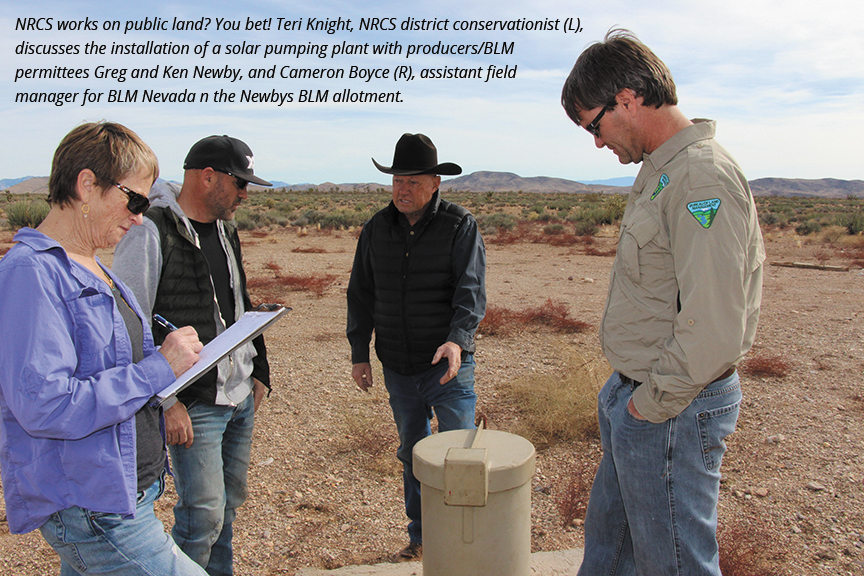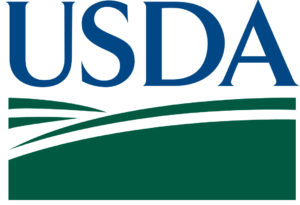
 The USDA’s Natural Resources Conservation Service (NRCS) in Nevada continued its conservation work across the state despite a tough 2020 marked with a pandemic and several natural disasters. The agency helped farmers, ranchers and forest landowners implement conservation practices on their working lands, which help conserve natural resource such as soil, water and wildlife as well as boost producers’ bottom lines. Additionally, NRCS launched new online tools that increased the efficiency, effectiveness and delivery of crucial programs.
The USDA’s Natural Resources Conservation Service (NRCS) in Nevada continued its conservation work across the state despite a tough 2020 marked with a pandemic and several natural disasters. The agency helped farmers, ranchers and forest landowners implement conservation practices on their working lands, which help conserve natural resource such as soil, water and wildlife as well as boost producers’ bottom lines. Additionally, NRCS launched new online tools that increased the efficiency, effectiveness and delivery of crucial programs.
“NRCS helps people help the land in the good times and the challenging times,” said Ray Dotson, NRCS State Conservationist in Nevada. “I have heard stories from across the state, where our team often uses creative means to help producers meet their conservation and business goals. Additionally, we continued our efforts to streamline program delivery and to work with our USDA counterparts to best serve the needs of producers.”
Key highlights from 2020 include:
Conservation Delivery Amid Pandemic: NRCS continued to deliver services during the COVID-19 pandemic using social distance guidelines, phone and online tools. This year, NRCS worked with producers and communities to:
- Develop more than 100,000 conservation plans nationally.
- Co-invest $1.32 billion through the Environmental Quality Incentives Program (EQIP) to put conservation practices on 10 million acres, as well as $507 million through the Conservation Stewardship Program (CSP) to put conservation enhancements on 9.3 million acres. This includes 63,962 acres of EQIP and 6,003 acres of CSP in Nevada.
- Enroll more than 430 new easements, totaling 230,000 acres, into the Agricultural Conservation Easement Program (ACEP). This includes 4,100 acres in Nevada.
- Enter into over 420 agreements with local sponsors to cooperatively implement emergency recovery measures through the Emergency Watershed Protection Program (EWP) and obligated more than $251 million in EWP funds in FY 2020.
Links to the above-mentioned programs:
EQUIP: nrcs.usda.gov/wps/portal/nrcs/main/national/programs/financial/eqip/
CSP: nrcs.usda.gov/wps/portal/nrcs/main/national/programs/financial/csp/
ACEP: nrcs.usda.gov/wps/portal/nrcs/main/national/programs/easements/acep/
Disaster Recovery Assistance: Wildfires, hurricanes, drought and the derecho had significant impacts on agricultural operations nationwide. NRCS coordinated closely with USDA’s Farm Service Agency (FSA) to deliver disaster assistance programs. EQIP-funded conservation practices, including streambank restoration and vegetative buffers, protect land from erosion, support disaster recovery and help mitigate loss from future natural disasters. And, in some cases, EQIP funds can assist livestock producers with emergency animal mortality disposal following a natural disaster event. NRCS also partners with communities to aid disaster recovery through the EWP program. In addition to responding to 55 disaster-related watershed emergencies, EWP projects were also completed that addressed issues of unique, local significance, including protection of properties in historically underserved Alaskan communities and projects that preserved critical infrastructure in rural Iowa counties.
Soil Health: NRCS continued to prioritize adoption of soil health management systems. In fiscal 2020, NRCS provided financial assistance to help producers plan to plant cover crops on 18 million acres and to use no-till on 7.3 million acres. Additionally, NRCS rolled out a new Soil Health Toolbox, which offered useful tools to demonstrate how soil functions and to help guide management decisions that will improve soil health with NRCS conservation practices.
Water Quality: NRCS continued its investments in targeted water quality initiatives, which increase the return on investment in terms of improving water quality in priority waterways. NRCS will continue its work through the National Water Quality Initiative and Mississippi River Basin Healthy Watersheds Initiative in 379 priority watersheds for fiscal year 2021.
Wildlife Habitat: Farmers and ranchers across the country have continued their work on managing for habitat on working lands. From the sagebrush sea in the West to the longleaf pine forests of the South, producers are making a difference for wildlife. NRCS continues to plan for future wildlife conservation, and this year rolled out a new five-year Working Lands for Wildlife conservation strategy for the gopher tortoise, the keystone species of longleaf pine forests in the Southeast. In Nevada, two Sage Grouse Initiative contracts for 1,638 acres were completed, as we continue work in sage grouse habitat areas.
Online Tools and Resources: NRCS and the Farm Production and Conservation (FPAC) Business Center rolled out a new decision tool this year for producers on farmers.gov. The Conservation Concerns Tool enables landowners to learn about conservation concerns that might impact their agricultural operations, then search for solutions targeted to fit their business needs. Producers can also find a new video series, called Conservation at Work, that spotlights how producers are using key conservation practices. In addition to finding information, producers can also log into farmers.gov to manage their conservation business online. During the past year, key functions from NRCS’s Conservation Client Gateway were moved to the farmers.gov portal to provide one place where producers can manage all their USDA business online.
Partnerships and Innovation: The Regional Conservation Partnership Program (RCPP) and Conservation Innovation Grants (CIG) Program continued to rally partners to help increase the reach of conservation and support the development of new tools, approaches, practices and technologies to further natural resource conservation on private lands. NRCS just closed the application period for RCPP, with plans to invest $360 million nationally in projects that improve the nation’s water quality, combat drought, enhance soil health, support wildlife habitat and protect agricultural viability. Additionally, NRCS invested $50 million nationally in 10 conservation projects through RCPP Alternative Funding Arrangements, where partners are given the liberty to manage projects and the associated relationships with producers and landowners directly. In October 2020, NRCS awarded more than $14.6 million in grants to 24 CIG projects nationally. This USDA investment has generated more than $15.3 million in partner matching funds, resulting in almost $30 million for conservation innovation nationally. Authorized in the 2002 Farm Bill, the CIG Program has awarded nearly $300 million to date.
In Nevada, the RCPP project with Duck Valley Indian Reservation working with their partners, including the Duck Valley Conservation District, tribal wildlife and parks, the business council, and the water board, concluded with great success. (Watch Video: https://youtu.be/opJ3VY-IE9g) The reservation saw the completion of a more efficient irrigation system, including installation of 25 nose pumps to provide frost-free winter water for livestock, and solar livestock watering systems in areas where the water table is greater than 25 feet that includes water wells with solar pumps, troughs, and pipelines. Several of the main diversion structures are now automated, allowing water delivery to be controlled from a computer, and submerged orifices were installed to effectively measure water throughout the reservation.
2018 Farm Bill Implementation: NRCS made tremendous strides in implementing the 2018 Farm Bill in the past year. NRCS published final rules for EQIP and CSP this fall and is preparing to publish final rules for ACEP and RCPP. Additionally, NRCS completed and published updates to its set of National Conservation Practice Standards, which includes 58 standards. (www.nrcs.usda.gov/wps/portal/nrcs/detail/national/newsroom/releases/?cid=NRCSEPRD1692218) The 2018 Farm Bill required review all 169 of its national conservation practices to seek opportunities to increase flexibility and incorporate new technologies.
NRCS is a part of the Farm Production and Conservation (FPAC) mission area at USDA. Other 2020 highlights can be found here: www.nrcs.usda.gov/wps/portal/nrcs/detail/national/newsroom/releases/?cid=NRCSEPRD1717843
All USDA Service Centers are open for business, including those that restrict in-person visits or require appointments. All Service Center visitors wishing to conduct business with FSA, NRCS or any other Service Center agency should call ahead and schedule an appointment. Service Centers that are open for appointments will pre-screen visitors based on health concerns or recent travel, and visitors must adhere to social distancing guidelines. Visitors are also required to wear a face covering during their appointment. Our program delivery staff will continue to work with our producers by phone, email and using online tools. More information can be found at farmers.gov/coronavirus.
MORE RESOURCES:
CONSERVATION CONCERNS TOOL: farmers.gov/conserve/tool
VIDEOS: farmers.gov/conserve/conservation-at-work
YOUR ACCOUNT: farmers.gov/sign-in
By Heather Emmons, State Public Affairs Officer
